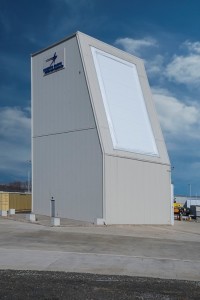Lockheed Martin [LMT] is pushing full steam ahead on its scalable AN/SPY-7 S-band gallium nitride-based radar in four countries and boasted its superiority to the Raytheon Technologies
[RTX] AN/SPY-6 radar in a recent interview.
SPY-7 is based on the Long Range Discrimination Radar (LRDR), procured by the Missile Defense Agency (MDA) to bolster the Ground-based Midcourse Defense (GMD) system’s ability to track ballistic missile threats at Clear Air Force Station in Clear, Alaska. LRDR aims to both better track missiles and discriminate among warhead-carrying vehicles and decoys and other non-lethal objects.

Beyond LRDR, the SPY-7 system is also set to be the radar used with the Aegis Weapon System on Spanish Navy F-110 class frigates, connect with the Aegis system on the Royal Canadian Navy’s new Halifax-class Canadian Surface Combatant ships, and was previously selected over Raytheon’s SPY-6 by Japan to be used in its now-canceled two Aegis Ashore sites.
“I think we’ve gotten a lot of good uptake on the SPY-7 technology. It’s really an adaptable capability. We really designed SPY-7 around what we call sub-array suites, which are really just building blocks of capability that we can build up in multiple configurations to support and tailor to a particular mission.” Jon Rambeau, vice president and general manager at Lockheed Martin Rotary and Mission Systems’ integrated warfare systems and sensors line of business, told Defense Daily during a Jan. 15 interview.
While Japan selected LRDR for its Aegis Ashore sites back in 2018, the government decided to completely scrap its plans in 2020 due to technical and cost concerns amid widescale local site opposition (Defense Daily, June 29, 2020).
Japan has since said for now it will focus on its sea-based Aegis ships for that element of missile defense capability.
Rambeau said the company is working with Japan and MDA as it seeks new sea-based solutions and is working with them as they would through trade analyses on seaborne platforms.
He noted while the company is principally working with the U.S. and three international customers, “certainly there will be others down the road.”
Rambeau also commented on delays to the LRDR system in Alaska related to the COVID-19 pandemic.
“I can tell you that we did have some delays due to COVID, we did have some restrictions at the site in Alaska and we did experience some delays. I think we worked through the bulk of that now,” he said.
Company spokesman Patrick McNally noted Lockheed Martin will deliver the radar to MDA in 2021, but the government would determine the schedule thereafter.
Previously, MDA planned to field the system in fiscal year 2021, before transferring it to the Air Force in FY ’22. In August, MDA director Vice Adm. Jon Hill acknowledged pandemic-related delays, but an annual Government Accountability Office’s report said initial fielding was delayed and the transfer to the Air Force is now expected in late FY ’23 (Defense Daily, Aug. 10, 2020).
Separately, Rambeau highlighted the company’s confidence in SPY-7 beating Raytheon’s SPY-6 in an even competition and is interested in using a version of SPY-7 to update older SPY-1 radar Aegis ships.
“Certainly, we’ve made clear to the Navy that if there’s an opportunity to compete for backfit work on the legacy fleet we’d certainly be more than happy to bring SPY-7 to the table in a head to head competition against SPY-6, I think we’d come out favorably in that.”

The SPY-6 Air and Missile Defense Radar (AMDR) is being produced for Arleigh Burke-class Flight III destroyers to improve its Aegis target tracking capabilities. The ships are larger than previous models to accommodate increased space, weight, power and cooling required to host the radar.
In a statement to Defense Daily, Lockheed Martin asserted various points of SPY-7 superiority over SPY-6 including having a larger logistics pool to support it with over 10,000 basic modules produced by the end of 2021 and that SPY-7 allows individual modules to be swapped out in under a minute while the system still radiates.
In a technical chart comparison between the systems, the company said unlike SPY-6, SPY-7 has polarization diversity, on-array digital beam forming, low power substates, requires a power supply of 375 volts vs. 1000 volts of direct current, has three times the search capacity, 1.2 times the raid capacity, and 1.3 times the range.
Lockheed Martin also noted SPY-7 is expected to have initial operational capability in 2021 compared to 2024 for SPY-6.
In October, the Navy’s land-based test site received the SPY-6 AMDR to test it for lessons learned in a controlled environment to correct any issues before it is integrated and deployed on the Flight III destroyer, starting with the future USS Jack H. Lucas (DDG-125). DDG-125 is planned for delivery in 2023 (Defense Daily, Oct. 8, 2020).
Raytheon previously said its system is 30 times more sensitive than radars deployed on current destroyers. Operational tests to evaluated AMDR performance on a destroyer are set for 2022.